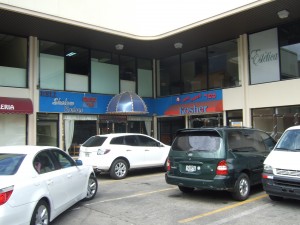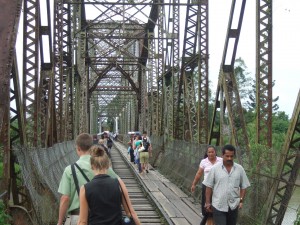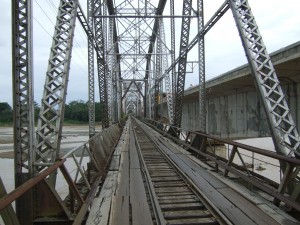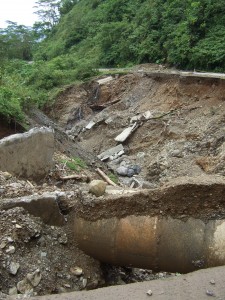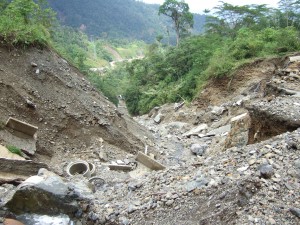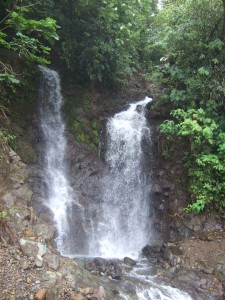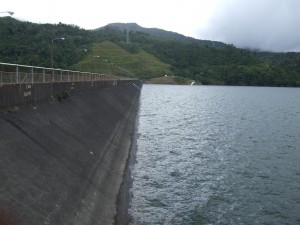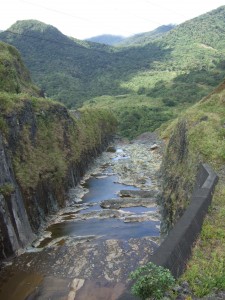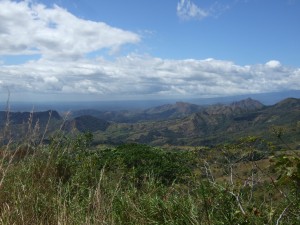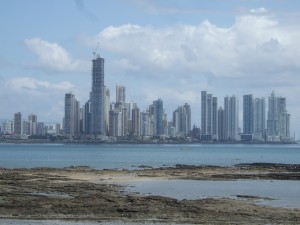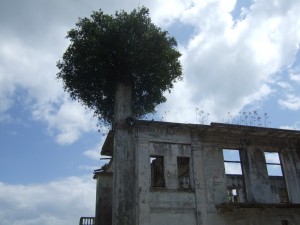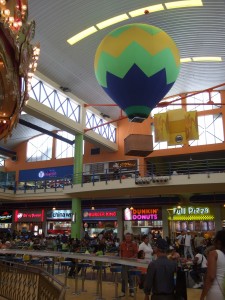Stuck in the middle with Jew
There were several reasons why reaching Panama had a special significance for us. First, it’s the mental halfway point, signifying the end of our North/Central-American trip, and the start of the South American one – the middle of our trip world. Second, it meant a brief respite from our routine: wake up, shower, eat breakfast, pack our things from a hotel back onto our bikes, ride till around the evening, find a hotel, unpack, have dinner, grab a few beers, and go to sleep. Lastly, it was the big question mark on the trip… how do we bridge the gap in the Panamerican Highway between Panama and Colombia? Before we could answer that question, we had to make it to Panama City, halfway across the country.
Crossing the Panamanian border won the country two awards for border crossings: fastest and easiest in Central America (commendable), and most dangerous anywhere I’ve seen. Also, Panama uses Balboas as their currency, which for some reason means they use USD bills, but mint their own coins, which look exactly like ours for the same denominations… but even if they list prices in Balboas, points for not needing to translate currencies. Anyhow, the border between Costa Rica and Panama is a river, and on the northern border we used, the nations decided to make use of an old railroad bridge. Perhaps 500 meters long, the bridge still had the original iron rails and wooden railroad ties. Wooden planks, warped with use and weather, had been roughly nailed longitudinally and three abreast to the ties on either side of the iron rails, but not in between them. Down to one lane, guards allowed one vehicle to pass the bridge at a time. Cars and trucks drove with the train tracks between their tires, and aside from being on rails and treated to a perhaps bumpy ride, they were safe. Motorcycles, however, were another story.
For us, it was a nightmare. Unable to use the safety of the middle of the bridge, which was still the original ties, we were forced to choose a side to ride down. Large iron nails had been used to attach the planks, and stuck out dangerously (for our tires at least) everywhere. Chainlink fence seemingly originally meant to serve as protection was now bent and warped. In the middle, the bottom of the fence had wandered several feet from the planks, treating us to unobstructed views of the river below. Dodging large nails and larger gaps, we slowly navigated the left side of the bridge. The wood was damp and flexed under our weight. We started on the middle of the three planks with our feet on either side to steady us, all too aware of the large amount of steadying a couple high-slung overloaded motorcycles need at low speed. When the outside plank disappeared, we moved to the inner plank, steadying ourselves with one foot on the ancient railroad rail, sliding along in the water, gazing at the fence bent by unknown accidents of old.
Ever so slowly, we reached the other bank of the bridge, and were once again in the wonderful world of paperwork. A guard told us where we could park our bikes and promised to keep an eye on them. He also had a motorcycle, and talked to us about them. We began the border process with our bikes, always the most complicated thing. As usual, we needed photocopies, and there wasn’t a photocopier in sight. The agent told us where to look, but that didn’t stop a score of children from trying to “help” us find it hoping for money. About 200 yards past the border building, there was a cell phone shop that made copies, and we marched back, picking up child beggers in both directions. We finished up our bike paperwork, and moved to the line for customs. In line with us were 4 other people we’d seen the night before at Rockin’ J’s, a group of three Americans and a Spanish woman. The other Americans and us found we were special cased by Panamanian customs, and had to buy tourist cards before we could enter.
$10 later, we were back in line at customs, and joking with the guard with the motorcycle. He gave us directions to the main road out of town (which was remarkably difficult to get to), and told us if we thought the bridge we’d taken to get to this side of the river was bad, we should look for a new definition of the word. He said there was another bridge, like this one but over a kilometer long, about 12 kilometers up the road, and that around 8 motorcycles fall off it a year. He advised us to take the left side of the tracks, and to walk it first so we really knew what we were getting ourselves into. Mulling over the thought of crossing a worse bridge than the one we’d already done, we completed our paperwork, amazed that it’d only taken about an hour, and with no dirty looks.
We followed the guard’s directions out of town, which was extremely handy since there were absolutely no signs, and the road he had us take didn’t look anything like what we’d expect to be the road out of town. A litte ways out, and we were stopped by a major roadblock: a rail had descended across the roadway, and bunches of bananas suspended from the rail were hauled across the roadway by people riding donkeys. I got a video on my camera, but sadly, no worthwhile photos.
The next town down was even more confusing. We had to ask for directions numerous times, and twice passed a turn we were supposed to take (completely non-obvious and totally unlabeled) only to have everyone on the street (or in a car) waving and pointing us the right way. It was clear that foreigners had trouble getting out of town, and we hardly had to ask for directions before cops, taxis, and pedestrians were pointing us in the right direction. Panama had so far been flatlands, but the one road out of town went up a mountain, then descended to the bridge we’d been warned about.
Next to a construction project for a new, sensible bridge was the kilometer long bridge of death. Construction workers stood at either side of the bridge, taking turns letting one direction of travel past. We parked our bikes and scoped things out. It was terrifying. Similar to the previous bridge, there were nails sticking up, boards missing, and vast stretches along the middle of the bridge where there was no guard rail to speak of at all. We psyched ourselves up to the point of being thoroughly terrified, asked the guy letting people across to let us be in the back of the pack, waited our turns, and went.
Trying my best to not look down, I inched my way down the bridge. Rushing water and bone-breaking rocks stared back when my eyes wandered. Time was the one thing moving slower than us, and it seemed like I was stuck on the bridge forever. Though we’d been at the end when we started, seeing how slow we were moving, the guy at the bridge let more people behind us on, though thankfully none of them honked or tried to rush us. I’d have to guess we were on the bridge for 8 terrifying minutes, but it seemed like an eternity. To date, this was the most dangerous thing we’ve done on the trip…
But we made it across, relieved to be alive to ride another day. The road then took a jog up what seemed like the only mountain range in the country, with views over endless flatlands of trees, and the bay of Bocas del Toro, which also sports a rather scenic archipelligo. Perhaps it was just the risidual adrenaline in my veins, but only one mountain range up and I was thinking Panama had some of the most beautiful scenery to date.
When we descended from the mountains, we were in the port town of Almirante. The road instantly became confusing, and had no labels. We tried stopping at the first hotel we saw, which happened to be called “2 Gringos,” but a couple kids came up to us and told us it was closed (after waiting for someone to answer the bell for a couple minutes). One of the kids on a bike also offered to help us find a different hotel, and led us down a dozen side streets before stopping by a shipping yard with a hotel across the street. It was full. Just up the street though, he led us to what may have very well have been the last hotel in town, not that you’d have known it, since it didn’t have any sign. It also didn’t have any rooms with two beds, so we splurged and got a third. Ahh, it’s great to be a “rich” American.
The next morning, we had the pleasure of once again trying to find the right road out of a Panamanian town. After a few lucky guesses, we were once again ascending in the mountains overlooking the ocean. Here we had a new twist on the always-spectacular mountain road. At each (frequent) bend of the mountains was a typical mountain river – a trickle of water tumbling down the mountain. Besides being incredibly common thanks to the cloud forest at the top of the mountain, each innocent trickle ran through a path of destruction of colossal proportions. Fifty feet or more of road was often shifted down the mountain several feet or swept completely away, great paths of boulders, broken pipe, asphalt, and upside-down trees cut through the vegetation, and there were boulders so large the road workers had given up on moving them from the highway and had instead painted them bright pastel colors in an attempt to improve their visibility.
We ascended up into the cloud forest feeding the streams, once again driving down a road that disappeared into swirling fog off the side of the mountain, the temperature rapidly changing from blazing hot to cold as blazes. Thankfully, unlike in Costa Rica, we crossed this ridge in the middle of the day, there was far less traffic, and we were descending again in a matter of minutes instead of hours. Our descent quickly showed us that the Panamanian government was trying to recoup some of its obviously significant roadway expenses thanks to the water, and had built a rather impressive dam.
Over the dam, into the mountains, we crested a final ridge and descended, through glorious lush vistas, and back into the Central American heat we know so well.
Sadly, our descent brought us down to the vast coastal plane that defines southern Panama. From there until Panama City, it was nearly all flat, hot, and consistent (read: boring by comparison) scenery. Stopping for lunch at a truck stop with a store in it, we were extremely pleased to see the result of being in an inexpensive country with a major international shipping port, as nearly all manner of goods were available at amazingly cheap prices as long as you didn’t mind that the labels were often in Russian or Chinese.
We ended our second night in Panama in the town of Santiago, which is relatively large by Panamanian standards. We found a wonderfully cheap and sleazy motel right on CA-1, and went out in search of dinner and civilization. We found Santiago to offer little of either beyond a sizeable soccer stadium, and we ended up eating at a food kiosk directly outside of it. As is nearly always the case when we stop at places most American tourists don’t stop, we seemed like the most popular guys in town. Afterwards, we gave up on finding any nightlife, and sleep came easy to the sound of our room’s air conditioner (hooray sleazy hotels!).
The next morning began the home stretch to Panama City. The two lane highway became crowded, then doubled to four lanes, and finally, we climbed a mountain and crossed the infamous Bridge of the Americas over the Panama Canal. Overlooking vast shipyards, a line of freighters and tankers adrift in the ocean, and the dense, skyscraper-heavy, and thoroughly modern Panama City skyline peaking out between mountain peaks, it was quite a sight for a couple weary travelers.
Panama’s issue with poorly marking its roadways was blatantly apparent in its Capital, with the delightful addition of extremely heavy traffic (consisting, of course, of drivers with absolutely no respect for motorcyclists), major intersections with no signs or traffic lights, and numerous one way streets. About a mile into the city, we asked at a gas station where we could find a nice cheap hotel, and they sent us towards the water to a district known as Calidonia.
Calidonia consists mostly of a major shopping district, the current civic center, and at least 30 hotels, packed in like sardines. Once we were off one the main shopping road, we parked our bikes and Joe went off to find one of the plethora of hotels that would suit our needs, at least for the first night. The first three hotels were all in the $40 range, and we eventually settled on the Hotel Covadonga, which still fell into the upper $30 range, but had off-street parking, hot water, and air conditioning – which were the only things we really needed – plus an elevator and a roof deck pool, offering us nice view of a beautiful city.
Panama City was an enigma to me. An international city thanks in no small part to the canal, Wikipedia also claims tourism is the most important revenue generator in the city, and Panama City boasts the 2nd highest in the world! The international influence was apparent in many ways, the most obvious being the construction: there are 127 high rise buildings and 110 new ones under construction… and nearly all of them are condos!And yet on the streets and in the restaurants, we were met with scowls and absolutely abhorrent service. We once waited over a half hour to order 2 cups of coffee, and another 20 minutes without receiving them before giving up and going elsewhere. Besides the high rises and new condos, most of the rest of the city seemed to exist with a complete dearth of maintenance.
Calidonia by day was a jumping neighborhood, with an endless market street packed with cars and foot traffic, and with massive shopping complexes spilling out onto the streets offering incredible bargains on name brand merchandise no-doubt freshly off a container ship destined for a country that marks goods up far more than Panama. I bought two name-brand polyester shirts to suppliment my supply for less than half what they would have cost in the US. Yet by 8pm, the area was completely desolate. Restaurants, stores, shops, everything was closed and shuttered. We’d often have to settle for hotel restaurants because they were the only things open. The streets were utterly unrecognizable at night from their promenance during the day. It was a complete dissappointment for me, who had hopes of a cosmopolitan city with troublesome nightlife… I found none.
We did find a cheaper hotel for our second night, and ended up spending the next 6 nights in the Residencia Touristica Texas, go figure! Stuck on the 4th floor, we lost our elevator, pool, and roof deck, but for under $30, we weren’t complaining. To save money, when we left, the receptionist would flip a light switch from a large bank of them behind his/her desk that turned off the power outlet to our air conditioner, so we never came home to a cold room. For internet, there was one wall in the 4th floor hallway I could hold my computer up to to recieve just enough signal to check my email.
We did a decent amount of touring around Panama, visiting Casco Viejo (the old part of town), the Amador Causeway (built as a tide breaker for the enterance to the canal extending far into the ocean, offering wildly overpriced restaurants as well as stunning views of the city and the ships waiting in the ocean to enter the canal), the canal (obviously), the former military base in the Canal Zone, and the most ridiculously americanized mall, the food court alone sporting a McDonald’s, Burger King, KFC, Popeyes, Wendy’s, Dunkin’ Donuts, Baskin Robbins, Pizza Hut, Subway, China Wok, and Dairy Queen! In our downtime, we also fixed some issues with our bikes, did some shopping, and did laundry for only the second time on the trip, though we do periodically hand-wash our polyester clothing in the shower for the kind of clean feeling you won’t see in Orbit Gum commercials.
But tourism and laundry weren’t our major enterprise in Panama, and our days were dominated by our goal of escaping Panama and drinking great coffee. Existing on instant coffee since leaving the states, in Panama, ordering a coffee got you a Cafe Americano – espresso mixed with water – and it was wonderful (and $1 or less!). We called every logistics company in the yellow pages and also got advice from a friend of a friend of Joe’s, Fernando, who works in shipping in Ecuador. We sent dozens of emails in the persuit of quotes and information. Our first quotes for shipping by water were reasonable, but a few rounds of questioning later, we’d ferreted out the approximately $600 in fees they’d forgotten to mention, and continued our search. We finally settled on a transport method – air – and a shipping company – Girag – Tuesday, picked up plane tickets on Wednesday, drove our bikes to the airport on Thursday (a 20 minute ride in no traffic and $3 in tolls per bike, and for us, a $1 per person bus ride back!), cabbed it to the Airport Friday morning, and had our bikes back under our well-rested asses by the late afternoon. The catch? We were in Bogotá, Colombia, the only country we’d planned on not going to on this trip!

